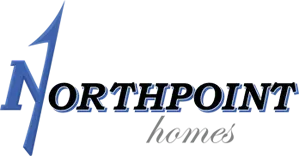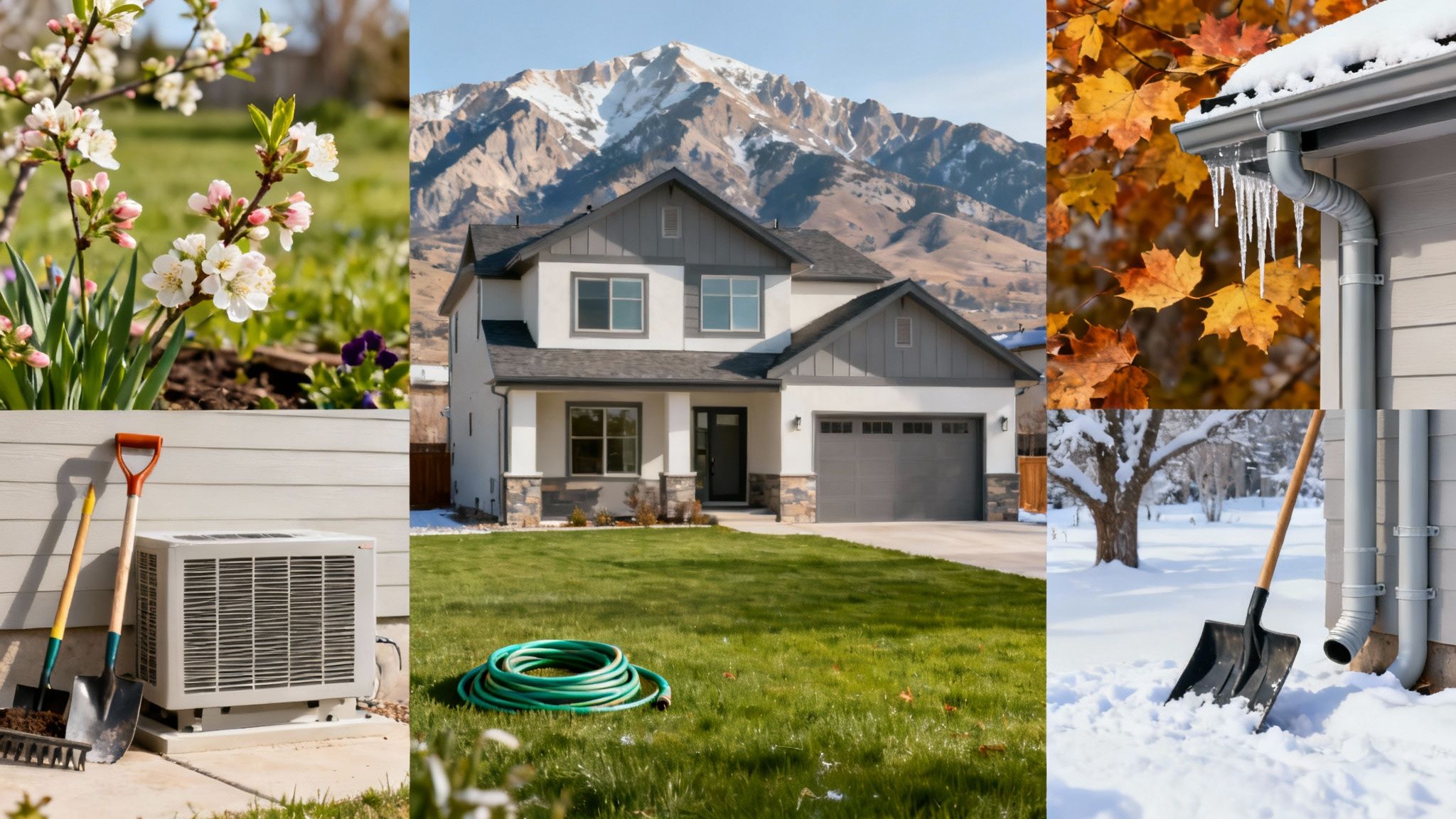Essential Seasonal Home Maintenance Checklist for Northern Utah
In Northern Utah, where the seasons bring distinct challenges from heavy snowfall in Provo to the summer sun in Lehi, proactive property maintenance is your first line of defense against costly repairs. A well-executed seasonal home maintenance checklist is the key to preserving your property's value, safety, and structural integrity, protecting your investment from the harsh and varied local climate.
This comprehensive guide moves beyond generic advice. It offers specific, actionable steps tailored for our unique environment. Whether you're managing a family home in Orem, a commercial building in American Fork, or a rental property in Saratoga Springs, these insights will empower you to tackle each season with confidence and precision.
We will break down the essential tasks you need to perform throughout the year, from winterizing your irrigation system to preparing your HVAC unit for a demanding summer. This checklist provides a clear, structured plan to ensure your residential or commercial property remains a valuable asset, not a source of unexpected expenses. Let's dive into the essential list that will keep your property in peak condition all year long.
1. HVAC System Filter Replacement and Maintenance
Your HVAC system is the heart of your home's comfort, and consistent maintenance is the key to its longevity and efficiency. This task involves more than just swapping out a filter; it's a proactive strategy to ensure optimal performance, improve indoor air quality, and prevent catastrophic failures. A dirty or clogged filter forces the system to work harder, leading to increased energy consumption and premature wear on critical components like the fan motor and compressor.
Why It's a Top Priority
Regular HVAC care directly impacts your wallet and well-being. According to the U.S. Department of Energy, a consistent maintenance schedule can reduce your system's energy consumption by 5% to 15%. For Northern Utah properties, this translates to significant savings during frigid winters and hot summers. For example, a multi-family property manager can cut tenant complaints about heating and cooling by over 50% simply by implementing quarterly filter checks and bi-annual professional tune-ups.
Actionable Maintenance Tips
To keep your system in peak condition, follow a simple but effective routine:
- Monthly Filter Check: Set a recurring reminder on your phone for the first of each month. Even if a filter is rated for three months, checking it monthly accounts for variable conditions like seasonal allergies or nearby construction.
- Bi-Annual Professional Service: Schedule a professional tune-up twice a year. Book a cooling check-up in early spring and a heating inspection in early fall to beat the seasonal rush and ensure you're prepared.
- Clear Outdoor Space: Maintain a minimum of two feet of clearance around your outdoor condenser unit. Remove leaves, branches, and any debris that could obstruct airflow.
To help you remember the core schedule, here is a quick reference guide summarizing the essential HVAC maintenance timeline.
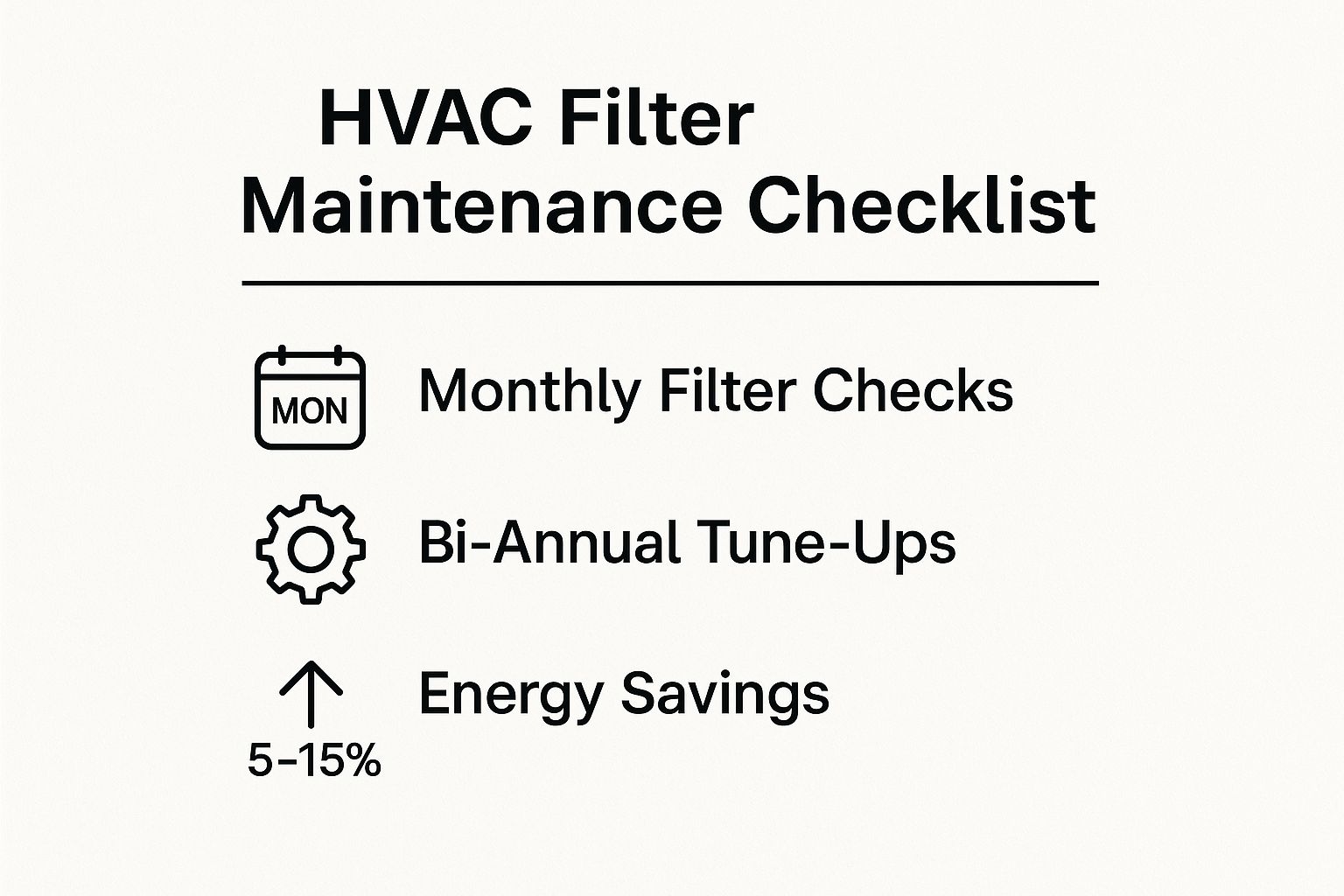
This checklist highlights the simple, repeatable actions that yield the greatest returns in energy savings and system reliability. By integrating these checks into your seasonal home maintenance checklist, you transform a reactive expense into a proactive investment.
2. Gutter Cleaning and Inspection
Your gutter system serves as a critical line of defense, directing water away from your home's foundation, siding, and roof. Proper gutter cleaning and inspection involves more than just scooping out leaves; it is a vital preventative measure to protect your property's structural integrity. Clogged gutters can lead to water overflow, causing costly damage like foundation cracks, basement flooding, and wood rot in your roof fascia and soffits.
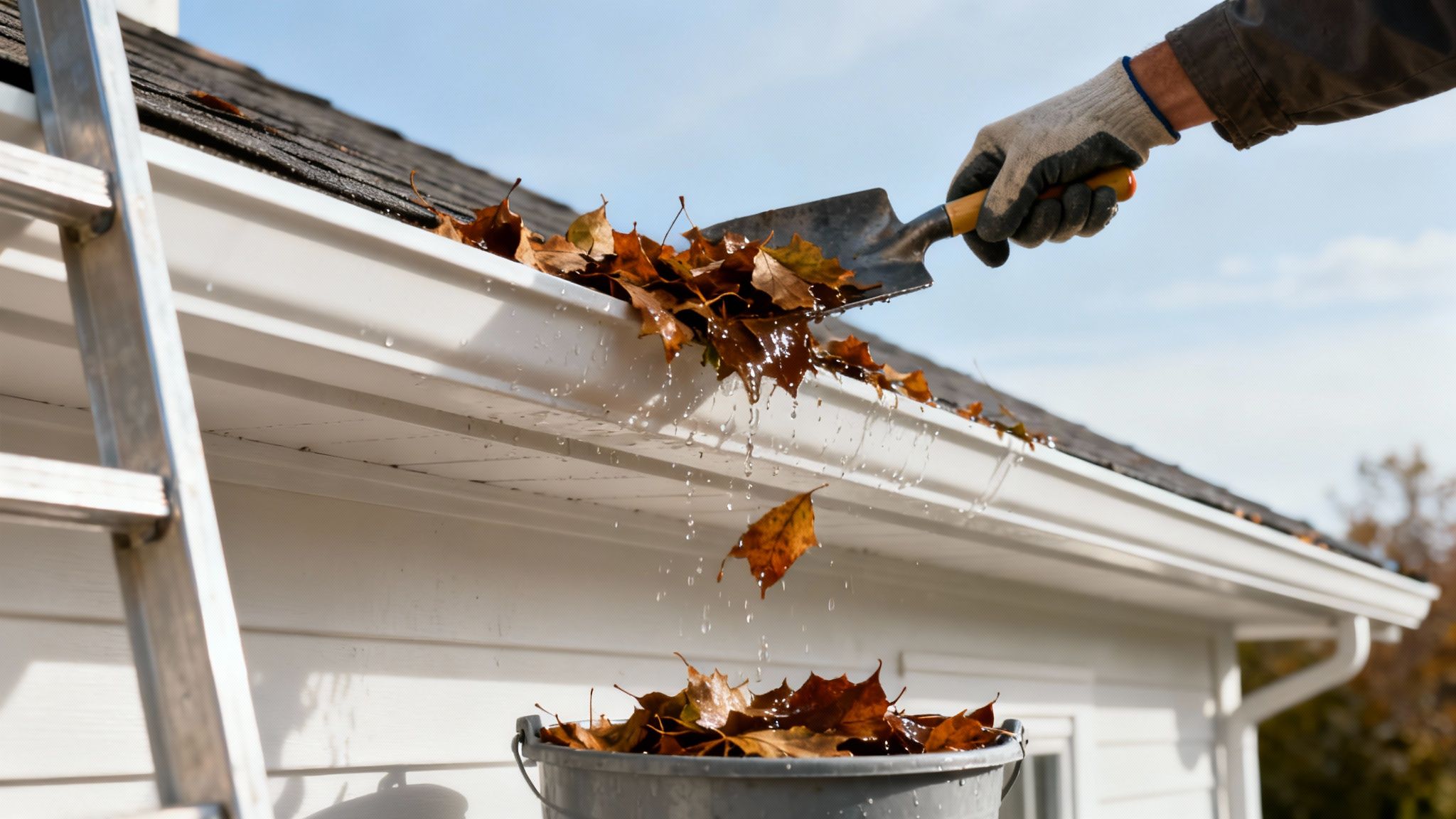
Why It's a Top Priority
Neglecting gutters is a direct invitation for water damage. A Northern Utah home can face severe ice dams in winter if gutters are clogged, forcing melting snow under roof shingles and into the attic. For example, a homeowner can prevent thousands of dollars in foundation repairs simply by ensuring gutters are clear before the heavy spring rains and autumn leaf fall. Regular maintenance also prevents pest infestations, as stagnant water in clogged gutters is a breeding ground for mosquitoes and other insects. This task is a cornerstone of any effective seasonal home maintenance checklist.
Actionable Maintenance Tips
To ensure your gutter system functions correctly, incorporate this routine:
- Twice-Yearly Cleaning: Schedule gutter cleaning for late spring after trees have dropped their seeds and late fall after most leaves have fallen. This timing is crucial for Northern Utah's distinct seasons.
- Flush the System: After removing large debris, use a garden hose to flush the gutters and downspouts. This confirms water is flowing freely and reveals any hidden blockages or leaks.
- Secure and Inspect: While cleaning, check that all gutters are securely fastened and sloped correctly toward the downspouts. Look for any signs of sagging, cracks, or rust that need repair.
- Extend Downspouts: Ensure your downspouts discharge water at least four to six feet away from your foundation to prevent water from pooling and seeping into your basement.
For those just starting their homeownership journey, understanding these essential tasks is key. You can discover more fundamental home maintenance tips for new homeowners that build upon these practices. By consistently performing these checks, you safeguard your property against its greatest threat: uncontrolled water.
3. Roof Inspection and Repair
Your roof is your home's first line of defense against the elements, and proactive inspections are essential to its integrity and longevity. This task involves a comprehensive visual examination of shingles, flashing, and structural components to identify wear or potential leaks before they cause catastrophic damage. Overlooking minor issues like a missing shingle or cracked flashing can allow water infiltration, leading to costly interior repairs, mold growth, and structural rot.
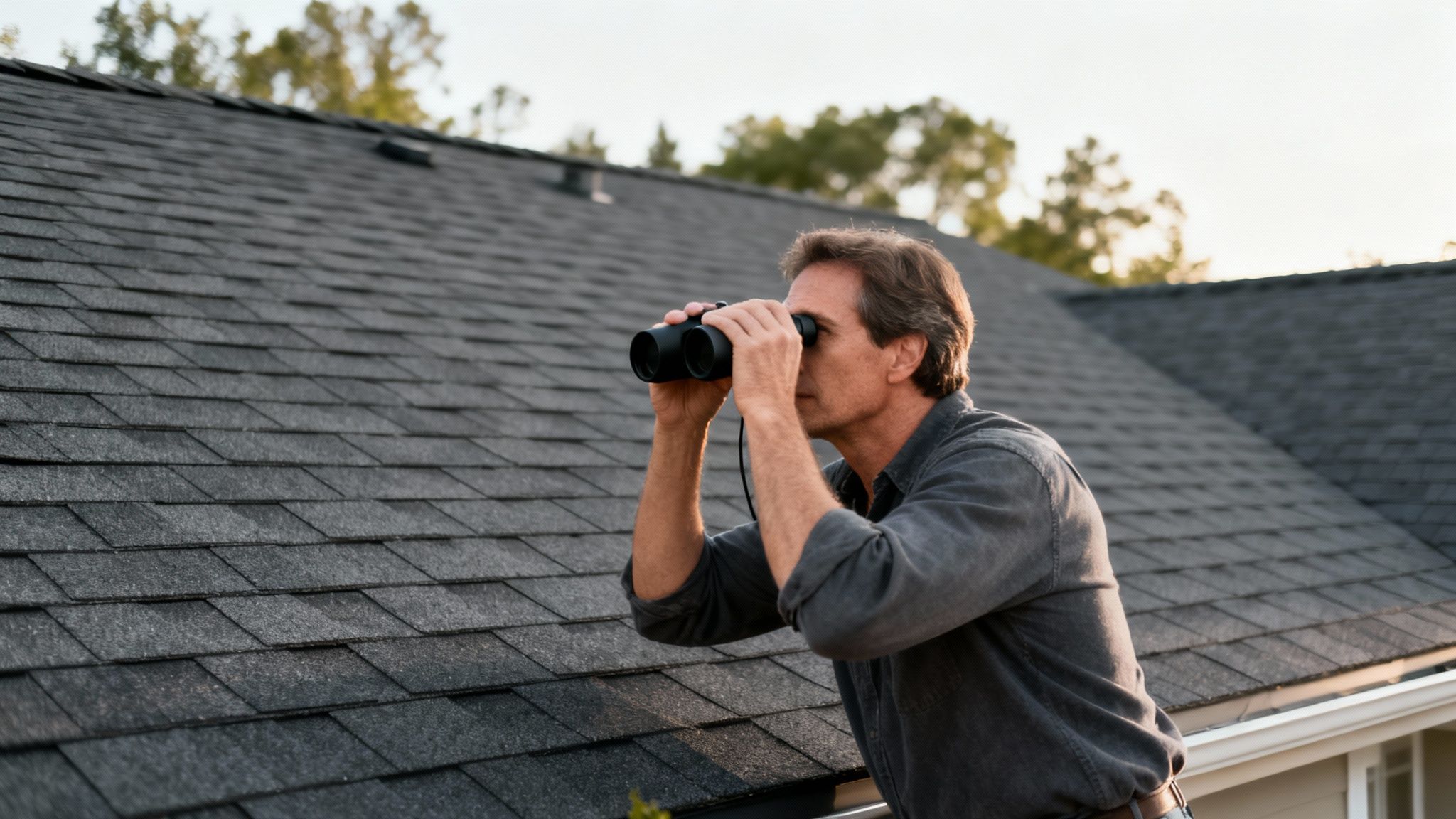
Why It's a Top Priority
Regular roof inspections are a critical part of any seasonal home maintenance checklist because they prevent small, affordable fixes from escalating into major financial burdens. For instance, a homeowner who spotted a small leak early spent just $300 on repairs, avoiding a potential $15,000 bill for interior water damage and mold remediation. For properties in Northern Utah, checking for damage after heavy snowfall or high winds is crucial to prevent ice dams and subsequent water intrusion, preserving the building's value and structural health.
Actionable Maintenance Tips
To effectively monitor and protect your roof, integrate these practices into your routine:
- Post-Storm Inspections: Always perform a visual check from the ground after major storms, heavy snow, or high winds. Use binoculars to safely inspect for missing or damaged shingles without climbing a ladder.
- Gutter Granule Check: When cleaning your gutters, look for an accumulation of shingle granules. This is a key indicator that your shingles are aging and may soon need replacement.
- Attic Leak Detection: During a heavy rainstorm, safely check your attic for signs of moisture, drips, or water stains on the underside of the roof deck. This is the fastest way to confirm an active leak.
- Professional Assessment: Schedule a professional roof inspection every 3 to 5 years, or immediately if you suspect damage. Experts can identify subtle issues that an untrained eye might miss.
4. Window and Door Weatherstripping and Caulking
Gaps around windows and doors are silent energy thieves, allowing conditioned air to escape and outside elements to intrude. Sealing these leaks with weatherstripping and caulk is one of the most cost-effective tasks on any seasonal home maintenance checklist. This simple process involves inspecting and replacing worn seals to prevent air leakage, water damage, and energy loss, directly boosting your home’s efficiency and comfort.
Why It's a Top Priority
Unsealed gaps can account for 10% to 25% of a home's heating and cooling costs. For properties in Northern Utah, with our distinct seasons, that's a significant expense. Properly sealing your home not only lowers utility bills but also enhances indoor comfort by eliminating drafts and preventing moisture infiltration that can lead to mold. For example, a Pennsylvania homeowner reported saving $340 annually on heating costs after completing a comprehensive weatherstripping and caulking project.
Actionable Maintenance Tips
To effectively seal your home and maximize energy savings, follow these targeted steps:
- Perform the "Candle Test": On a windy day, carefully hold a lit candle or incense stick near window and door frames. If the flame flickers, you've found an air leak that needs sealing.
- Choose the Right Sealant: Use silicone-based caulk for areas exposed to moisture, like window exteriors. For interior trim that you plan to paint, acrylic latex caulk is the ideal choice.
- Prepare the Surface: Always remove old, cracked, or peeling caulk completely with a utility knife or caulk remover before applying a new bead. A clean surface ensures a durable, airtight seal.
- Don't Forget Door Sweeps: Install or replace sweeps at the bottom of all exterior doors. This small addition creates a powerful barrier against drafts and is a critical part of a complete sealing strategy.
5. Exterior Drainage and Foundation Grading Check
Your home's foundation is its literal bedrock, and protecting it from water is one of the most critical parts of any seasonal home maintenance checklist. This task involves a careful inspection of your property's exterior drainage and grading to ensure water is channeled safely away from the structure. When soil slopes toward your home or drainage systems are clogged, water pools against the foundation, creating immense hydrostatic pressure that can lead to cracks, leaks, and catastrophic structural failure.
Why It's a Top Priority
Proper grading and drainage are your first line of defense against water intrusion. The American Society of Home Inspectors (ASHI) emphasizes that most basement moisture problems are due to issues with exterior water management. For example, a Michigan homeowner prevented an estimated $18,000 foundation repair simply by adding soil to correct negative grading that was funneling water toward their house. For property managers, a proactive drainage assessment can prevent costly tenant disruptions and structural repairs, reinforcing the value of a comprehensive property inspection checklist.
Actionable Maintenance Tips
To safeguard your foundation from water damage, integrate these checks into your routine:
- Grade Assessment: After a heavy rain, observe how water flows around your property. Ideally, the soil should slope away from the foundation at least six inches over the first ten feet. Use a string and level to verify this slope.
- Sump Pump Test: If you have a sump pump, test it quarterly. Pour a bucket of water into the sump pit to ensure the float switch activates and the pump engages correctly.
- Downspout and Drainage Maintenance: Ensure all downspout extensions direct water at least ten feet away from the foundation. Clear any debris from French drains, swales, and other drainage channels to maintain unobstructed flow.
6. Deck and Outdoor Structure Maintenance
Your outdoor living spaces, including decks, patios, and pergolas, are extensions of your home that require regular upkeep to remain safe and appealing. This maintenance involves more than a quick sweep; it's a critical process of inspecting, cleaning, and preserving these structures. Neglecting this part of your seasonal home maintenance checklist can lead to costly repairs, structural failure, and safety hazards from rot, loose railings, or weakened support boards.
Why It's a Top Priority
Proactive deck and outdoor structure care is a direct investment in your property's value and safety. According to the North American Deck and Railing Association (NADRA), proper maintenance can significantly extend a deck's lifespan, often by more than a decade. For a Northern Utah property, this means ensuring your deck can withstand heavy snow loads in winter and intense sun in summer. A simple annual inspection can uncover issues like a compromised ledger board before it leads to a catastrophic and dangerous collapse.
Actionable Maintenance Tips
To preserve the integrity and beauty of your outdoor structures, integrate these steps into your routine:
- Annual Spring Inspection: Before the heavy use season begins, thoroughly inspect the entire structure. Pay close attention to the ledger board where the deck attaches to the house, as this is a common failure point.
- Clean and Seal Correctly: Use an oxygen bleach-based cleaner, not chlorine bleach which can damage wood fibers. After cleaning, allow the wood to dry for at least 48 hours before applying a quality stain or sealant when temperatures are between 50-90°F.
- Ensure Proper Drainage: Regularly clear debris like leaves and pine needles from between deck boards. This simple action prevents moisture from getting trapped, which is a primary cause of mold, mildew, and rot.
7. Chimney and Fireplace Inspection and Cleaning
Your fireplace and chimney are more than just cozy features; they are complex systems that require regular attention to operate safely and efficiently. An annual inspection and cleaning is a critical safety measure, preventing dangerous chimney fires and ensuring harmful combustion gases are properly vented outside. Neglecting this task allows flammable creosote to accumulate and structural issues to worsen, posing a direct threat to your property and its occupants.
Why It's a Top Priority
Proper chimney maintenance is a non-negotiable aspect of fire prevention. The Chimney Safety Institute of America (CSIA) highlights that even a 1/8-inch buildup of creosote is enough to fuel a destructive chimney fire. For instance, a Colorado homeowner's annual inspection revealed a cracked flue liner, a defect that could have silently leaked carbon monoxide into their living space. In Northern Utah, where fireplaces are heavily used during long winters, this task is an essential part of any seasonal home maintenance checklist.
Actionable Maintenance Tips
To ensure your fireplace is safe for the season, integrate these steps into your routine:
- Annual Professional Inspection: Schedule a certified chimney sweep to inspect and clean your system every fall before the burning season begins. They can identify issues like creosote buildup, blockages, and structural damage.
- Burn the Right Fuel: Use only seasoned hardwoods. Avoid burning green wood, treated lumber, or trash, as these produce excessive smoke and creosote.
- Install Protective Hardware: A chimney cap is essential for preventing rain, debris, and animals from entering the flue, which can cause blockages and water damage to the masonry.
- Monitor Between Cleanings: Use a flashlight to periodically look up the flue from the firebox to spot any obvious obstructions or heavy soot buildup between professional visits.
- Install Detectors: Ensure you have working carbon monoxide and smoke detectors on every level of your home, especially near sleeping areas, as a primary line of defense.
8. Water Heater Maintenance and Flushing
Your water heater works tirelessly behind the scenes, and its health is vital for both comfort and your home's structural integrity. Proactive maintenance is not just about extending its life; it's a critical safety measure to prevent leaks, improve energy efficiency, and ensure a reliable supply of hot water. Over time, mineral sediment builds up at the bottom of the tank, acting as an insulator that forces the heating element to work harder and longer, increasing energy costs and stressing the unit.
Why It's a Top Priority
Neglecting your water heater can lead to a sudden, catastrophic failure, resulting in significant water damage and expensive replacement costs. For properties in Northern Utah, where hard water is common, sediment buildup accelerates corrosion and reduces efficiency. A homeowner in an area with hard water can improve their unit's efficiency by up to 25% with a dedicated flushing schedule. This simple task on your seasonal home maintenance checklist can mean the difference between a 15-year lifespan and a premature replacement in under eight years.
Actionable Maintenance Tips
To keep your water heater running safely and efficiently, incorporate these steps into your annual routine:
- Annual Flushing: Drain and flush the tank once a year to remove sediment. In areas with hard water, increase the frequency to every six months.
- Test the TPR Valve: Once a year, test the temperature-pressure relief (TPR) valve by briefly lifting the lever. It should release a burst of hot water into the drain tube. If it doesn't, it needs immediate replacement.
- Check the Anode Rod: Inspect the anode rod every two to three years and replace it if more than six inches of the core steel wire is exposed. This "sacrificial" rod prevents the tank itself from rusting.
- Set Temperature to 120°F: For optimal safety and energy efficiency, set the thermostat to 120°F. This temperature is hot enough for household needs while reducing the risk of scalding and slowing mineral buildup.
By making water heater care a non-negotiable part of your annual plan, you invest in your home's long-term health. For a deeper dive into how this task fits into a larger strategy, learn more about our proactive maintenance solutions for your property.
9. Lawn and Irrigation System Seasonal Care
Your lawn and irrigation system are a living part of your property, requiring precise seasonal adjustments to thrive and operate efficiently. This maintenance is a year-round cycle, from spring startup and summer optimization to fall winterization. Proper care not only enhances curb appeal but also conserves water and prevents expensive damage, such as burst pipes during a Northern Utah winter. Neglecting this crucial task can lead to a stressed lawn, high water bills, and costly system repairs.
Why It's a Top Priority
Strategic lawn and irrigation care is a direct investment in your property's value and sustainability. For example, a homeowner can avoid an average of $1,800 in frozen pipe repairs simply by performing a thorough fall winterization. In a commercial context, a property manager can reduce landscape water consumption by up to 40% by correctly programming the irrigation controller for seasonal needs and ensuring sprinkler heads are properly adjusted. This proactive approach turns a major expense into a manageable, predictable part of your seasonal home maintenance checklist.
Actionable Maintenance Tips
To maintain a healthy landscape and a reliable irrigation system, adopt this seasonal routine:
- Spring Startup: After the last frost, slowly pressurize your system and inspect for leaks. Check and adjust all sprinkler heads to ensure they water the lawn, not the pavement, and replace any damaged components.
- Fall Winterization: Before the first hard freeze, shut off the water supply and use an air compressor (at or below 50 PSI) to blow all water from the lines, preventing ice damage.
- Seasonal Controller Adjustments: Program your controller for deep, infrequent watering in the early morning (4-8 AM). Install a rain sensor to automatically skip cycles during wet weather, conserving water and preventing over-saturation.
Seasonal Home Maintenance Task Comparison
| HVAC System Filter Replacement and Maintenance | Moderate – monthly DIY + bi-annual professional visits | Filters, tools, professional service ($150-400/year) | Improved air quality, energy savings (5-15%), extended system life | Homes with HVAC systems, seasonal climate control | Energy savings, system longevity, warranty compliance |
| Gutter Cleaning and Inspection | Low to Moderate – DIY possible but ladder use required | Tools, ladder, optional professional service ($100-300/cleaning) | Prevents water damage, foundation protection, pest control | Homes with gutters, especially near trees | Prevents flooding, low cost relative to damage |
| Roof Inspection and Repair | Moderate to High – safe inspections critical, some repairs complex | Binoculars (DIY), professional inspections ($150-400), costly repairs if needed | Prevents water damage, extends roof life, early repair savings | Homes in storm-prone or harsh climates | Early problem detection, insurance compliance |
| Window and Door Weatherstripping and Caulking | Low – DIY friendly, annual maintenance | Caulking materials ($50-150 DIY), optional professional ($200-500) | Reduced energy costs (10-20%), improved comfort, water and pest prevention | Homes seeking energy efficiency upgrades | High ROI, comfort improvement, low cost |
| Exterior Drainage and Foundation Grading Check | Moderate to High – may require heavy labor or professionals | Tools, soil/materials, professional regrading ($1,000-3,000+) | Prevents foundation damage, flooding, mold and erosion | Homes with drainage issues or foundation concerns | Major damage prevention, structural protection |
| Deck and Outdoor Structure Maintenance | Moderate – labor-intensive, some carpentry skills needed | Cleaning/sealing materials ($100-300 DIY), professional refinishing ($500-2,000) | Extended deck lifespan, safety, preserved aesthetics | Homes with wooden/composite outdoor structures | Safety assurance, property value preservation |
| Chimney and Fireplace Inspection and Cleaning | Moderate – annual professional service recommended | Professional cleaning ($150-400), inspection tools, safety equipment | Fire hazard reduction, carbon monoxide safety, improved heating efficiency | Homes with fireplaces or wood stoves | Fire prevention, health safety, insurance compliance |
| Water Heater Maintenance and Flushing | Low to Moderate – DIY possible annually | Tools, hose, anode rod replacement ($20-50 DIY), professional service ($100-200) | Extended lifespan, increased energy efficiency (~20%), prevents leaks | Homes with conventional or gas water heaters | Cost savings, reliability, energy efficiency |
| Lawn and Irrigation System Seasonal Care | Moderate – seasonal tasks requiring timing and equipment | Irrigation tools/supplies ($100-300 DIY), professional service ($75-200/visit) | Healthy lawn, water savings (30-50%), system durability | Homes with irrigation systems and lawns | Water conservation, landscape health, damage prevention |
Your Partner in Year-Round Property Preservation
Navigating the demands of property ownership can often feel like a constant battle against the elements, especially in a region with distinct seasons like Northern Utah. This comprehensive seasonal home maintenance checklist is designed to be your roadmap, transforming a potentially overwhelming list of chores into a structured, proactive plan. By breaking down essential tasks into manageable, season-specific actions, you move from a reactive state of fixing problems to a strategic position of preventing them entirely.
We've covered the critical systems that keep your property functional, safe, and valuable. From the semi-annual ritual of cleaning your gutters to prevent water damage and inspecting your HVAC system to ensure year-round comfort, each task is a vital piece of a larger puzzle. Regular attention to your roof, windows, and foundation grading isn't just about upkeep; it's about protecting the structural integrity of your investment from moisture intrusion, which can lead to costly repairs. Similarly, maintaining outdoor structures like decks, inspecting your chimney, and flushing your water heater are proactive measures that enhance safety and extend the lifespan of these crucial components.
From Checklist to Lasting Value
The true benefit of adhering to a seasonal home maintenance checklist extends far beyond simply ticking off boxes. It’s about cultivating a deep understanding of your property's unique needs and rhythms. This proactive approach yields significant returns:
- Financial Savings: Catching a small roof leak, a grading issue, or a failing water heater element early can save you thousands of dollars in emergency repairs and collateral damage.
- Enhanced Safety: A clean chimney prevents fires, properly sealed windows improve indoor air quality, and a well-maintained HVAC system ensures your family or tenants are safe and comfortable.
- Increased Property Value: A well-maintained property not only holds its value but appreciates more consistently. Meticulous records of regular maintenance are a powerful selling point for future buyers.
Mastering this routine creates peace of mind. It liberates you from the anxiety of unexpected system failures and allows you to enjoy your home or manage your commercial property with confidence. This checklist is your framework, but the ultimate goal is to build a lasting legacy of care and preservation that protects your most significant asset for years to come. Your property isn’t just a structure; it’s an investment in your future, and proactive maintenance is the best insurance you can have.
Ready to take the guesswork out of property maintenance? For those complex tasks on your seasonal home maintenance checklist or for specialized projects like home remodels and tenant improvements, the experts at Northpoint Construction are here to help. Let us be your professional partner in preserving and enhancing the value of your Northern Utah property.
